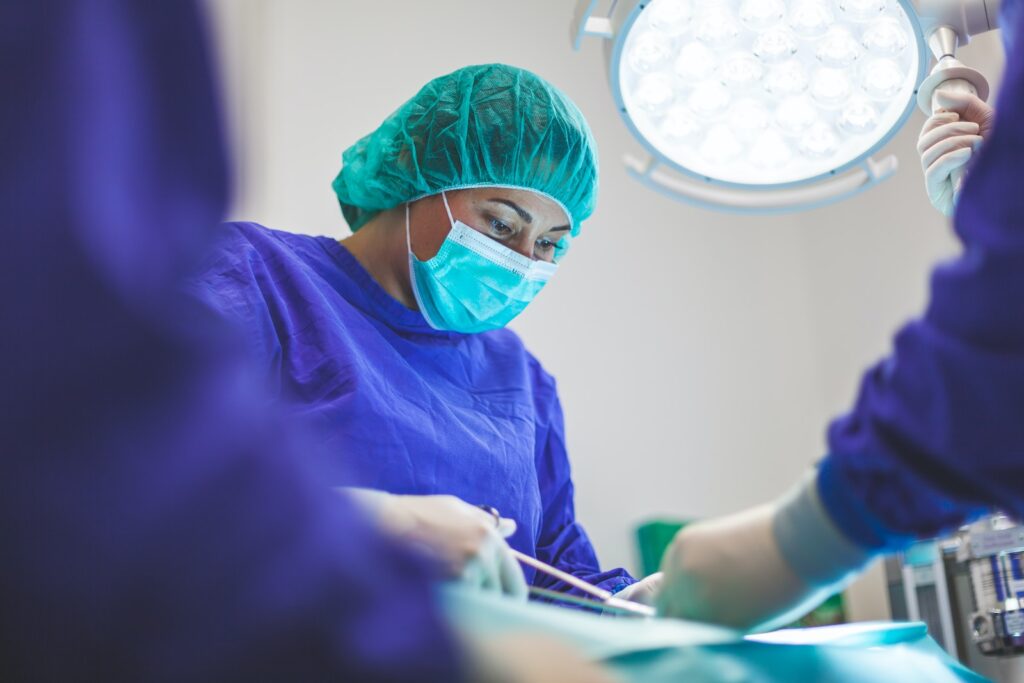Table of Contents
Introduction to Robotic Surgery: Definition and Brief History
Robotic surgery, also known as robot-assisted surgery or computer-assisted surgery, is a type of minimally invasive surgical procedure that uses robotic systems to perform surgeries. The main advantage of robotic surgery over traditional open surgeries is its minimally invasive nature, which results in less tissue damage and blood loss. This leads to faster healing times and fewer post-surgical complications for the patient.
The history of robotic surgery dates back to the early 1980s when researchers at Stanford University developed a prototype system called the “PUMA” (Programmable Universal Machine for Assembly). In 1985, PUMA was used in a successful neurosurgical biopsy on a human patient. Since then, there have been many advances in robotics technology that have led to more sophisticated surgical systems.
In the late-1990s, Intuitive Surgical introduced one such system – da Vinci Surgical System – which quickly became popular among surgeons due its high precision and accuracy. With intuitive controls and advanced magnification capabilities, this robotic surgical system enabled surgeons to perform complex procedures with greater ease and precision than ever before.
Today there are several different types of robots being used for various types of surgeries including prostatectomies (prostate removal), hysterectomies (uterus removal), colorectal surgeries, lung resections and many others. In fact, nearly every specialty has seen some sort of utilization from robotics technology since it first emerged nearly four decades ago..
How Does Robotic Surgery Work?
Robotic surgery is a relatively new form of minimally invasive surgical procedure that utilizes specialized robotic systems to perform a wide range of operations on patients. Unlike traditional open surgeries where large incisions are made, robotic surgery involves making small incisions and inserting tiny instruments into the body.
The surgeon operates these instruments from an external console, using advanced computer software to control and maneuver them with incredible precision. The system’s enhanced vision capabilities allow for a better view of the internal organs and tissues than can be achieved by human hands alone, which in turn enables more complex surgeries to be safely performed.
The robot follows the surgeon’s movements precisely, allowing for greater accuracy when performing delicate maneuvers such as suturing or dissecting tissue. Additionally, robots can use specialized tools like lasers or ultrasound to provide therapeutic treatments without damaging surrounding healthy tissue.
One major advantage of robotic systems is their ability to eliminate hand tremors that might otherwise cause errors during procedures. This means that even highly complex surgeries can be done with significantly less risk and downtime compared to traditional methods.
In addition, because robotics allows surgeons increased dexterity and agility within confined spaces in the body – such as around vital organs – there may ultimately be fewer complications associated with certain types of procedures.
Advancements in Robotic Surgery Technology: What’s New?
Robotic surgery has come a long way since its introduction in the late 1980s. The first robotic surgical system approved by the FDA was used for prostate surgeries, and it was limited to only a few hospitals due to its cost and complexity.
Today, there are several robotic systems available on the market with improved performance, precision, and ease of use. One of the most noteworthy advancements is the integration of artificial intelligence (AI) algorithms that allow robots to learn from surgeons’ actions.
Surgeon feedback has been crucial in developing new technology features that help improve robotic surgery. For instance:
- Haptic feedback: This feature provides tactile sensation during surgery allowing surgeons to feel as if they have their hands inside the patient’s body
- Better visualization: High-definition cameras provide an even clearer view than before so that tools can be positioned more accurately during procedures
- Motion scaling: It allows for smaller incisions through precise motions which reduces pain and quicken recovery time
- Natural orifice entry points :: Robotic instruments designed with flexible tips allow easier access through natural orifices like vagina, mouth etc., making certain surgeries less invasive
In addition to these improvements within existing technologies, research is ongoing on developing completely new types of robotics platforms. For example researchers are working towards micro-robots that could perform minimally invasive procedures at cellular levels. These tiny devices would find diseased cells within blood vessels or organs much quicker without causing potential damage along their path.
Other noteworthy developments include the use of virtual reality (VR) and augmented reality (AR) to help simulate surgeries for training purposes. VR technology creates a digital environment that can be manipulated with tools in order to practice complex procedures before working on real patients. On the other hand, AR is used in collaboration with robotic surgery during actual procedures. The surgeon can see additional information overlaid onto their field of view through headset or display about patient’s anatomy so they know exactly where critical structures are located within the body.
In conclusion, advancements in robotic surgery technology have rendered it more accessible than ever before providing surgeons greater control and improved outcomes for their patients. As we learn more about what robots are capable of doing we will likely continue seeing revolutionary changes throughout surgical fields.
Benefits of Robotic Surgery for Patients
Robotic surgery has become increasingly popular as an alternative to traditional surgical procedures. It offers numerous benefits to patients when compared with the conventional surgery methods:
- Precise and Accurate: The precision level of robotic surgeries is unmatched by traditional surgeries, allowing surgeons exceptional accuracy during operations. This means that there is much lower risk of damage to surrounding tissues and organs.
- Faster Recovery Time: In most cases, patients who undergo robotic surgery can expect a shorter recovery time than those who opt for traditional procedures. This is because the incisions made during robotic surgeries are small, which results in minimal trauma to surrounding tissues and less postoperative pain.
- Lower Risk Of Infections: The ability to perform more precise movements using robots minimizes bleeding during the operation process and lowers the risks associated with open wounds being exposed to harmful pathogens.
- Lesser Blood Loss: The use of robotics allows for smaller incisions resulting in lesser blood loss reducing chances of transfusions or anemia later on.
- Better Surgical Outcomes: Robotic assistance enables complex surgical procedures like prostatectomies with more success rates, reduced failures due to human errors leading towards higher patient satisfaction levels after treatment completion .
All these benefits make robotic surgery a highly effective option for treating conditions involving vital organs where it’s crucial not only to treat effectively but also safely reduce any complications related concerns post-surgery. Making this procedure increasingly preferred over laparoscopic or open surgical options available nowadays.
Benefits of Robotic Surgery for Surgeons and Hospitals
The use of robots in surgery has been a game changer, not only for patients but also for surgeons and hospitals. Here are some benefits that robotic surgery provides to surgeons and hospitals:
- Improved Precision. Unlike traditional open surgeries, where the surgeon’s hand movements might be shaky or unsteady at times, robot-assisted surgery enables steady hands thanks to sophisticated filters applied on tremors in real-time by computer software. As a result, even highly complex procedures can be performed with greater precision
- Enhanced Dexterity. The advanced tools used in robotics allow an almost frictionless range of motion within smaller spaces as compared to human hands which have limited degrees of freedom. Surgeons can make more considerable movement while operating without any strain or fatigue
- Faster Recovery Times. Most surgeries require extended hospital stays and long periods before recovery can begin; however, robot-assisted surgeries often lead to less postoperative pain than other surgical methods in addition to reducing blood loss during the procedure itself – factors that enable faster recovery times all-around leading increased patient satisfaction ratings along with reduced costs due fewer readmissions
- Limited Incisions. Thanks to the miniature instruments used by robots-aided technology allowing tiny incisions made instead large ones required traditionally which is beneficial towards lowering post-operative infection rates while saving time spent manually stitching back up wounds too!
- Better Visualization Inside Body Cavities.In conventional approaches such as laparoscopy (an approach involving small holes cut into skin through which cameras & instruments inserted) pictures captured may sometimes obscure details since they aren’t true-to-life to what’s happening in the patient’s body cavity. In contrast, robotic assisting tools provide surgeons with much better depth perception by incorporating 3D imaging technology which offers more detailed visuals and a clearer understanding of what is happening inside the human body; thus enabling them to achieve greater accuracy when performing surgical procedures.
- Improved Record Keeping: With robotics-assisted technologies comes advanced digital record-keeping options that negate the possibility of losing or misplacing medical records; these electronic systems facilitate streamlined workflows for doctors and administrators alike while also providing significantly higher levels of detail regarding patient care – allowing better tracking long term as well as improved documentation for insurance claim submissions).
In conclusion, robot-assisted surgery has brought significant advantages not only to patients but also to hospitals and surgeons. The level of precision and control it provides during surgeries reduces recovery times making it possible for those involved in operations vast benefits while simultaneously reducing complications that arise from traditional methods implying an improvement in overall healthcare standards save money on multiple fronts such as reduced hospital stays post-surgery, fewer readmissions due shorter recuperation periods.
Future Outlook on the Use of Robotics in Healthcare
The use of robotics in healthcare has already expanded significantly over the past decade, and it is showing no signs of slowing down. As robotic technologies continue to advance and improve, their applications in medicine will only become more diverse and far-reaching.
One area where we are likely to see significant growth is in minimally invasive surgical procedures. Robotic surgery allows for smaller incisions, less blood loss, faster recovery times, and reduced pain compared to traditional open surgeries. This means patients can return to their normal activities sooner with fewer complications.
In addition to improving surgical outcomes for patients, robots are also being used increasingly for tasks such as medication delivery, patient monitoring and care coordination; remote consultations via video calls; triaging patients or providing real-time diagnostic feedback.
There’s still a lot that needs to be accomplished before these advancements come into full bloom – like accessibility issues particularly when it comes cost effective solution so that advanced medical technology doesn’t remain confined within metropolitan facilities but reaches out effectively across rural areas too which would enable underprivileged population having access at basic health-care services without any delay or interruption history reasons.(please only add this line if staying under character limit)
All things considered with recent advancement obtaining optimal treatment through smart solutions seems like an incredibly promising future direction for Healthcare industry leveraging AI robots as fundamental tools of modern Medicine.”(as per the context add your own conclusion note- Optional )




